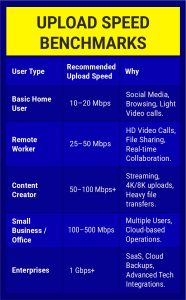Why Upload Speed Matters More Than Ever in 2025–2026
For years, internet users have judged their connections by one metric: download speed. After all, most online activity was about consuming content streaming movies, downloading music, or browsing websites. But the digital world has changed dramatically. In 2025–2026, upload speed has become just as important — if not more — than download speed. From video calls and cloud backups to streaming and AI-powered tools, much of today’s internet activity depends on how fast data can move from your device to the internet.
In this blog, we’ll explore why upload speed matters more than ever, the consequences of ignoring it, benchmarks you should aim for, and how to future-proof your connection.
What Is Upload Speed?
Before diving into its importance, let’s define upload speed.
- Upload speed measures how fast data travels from your device to the internet.
- It is expressed in megabits per second (Mbps).
- Examples of uploading: sending emails with attachments, sharing files to Google Drive, or streaming live video.
By contrast, download speed measures how fast data comes to you from the internet — for example, when you download a movie or load a webpage.
Historically, download speeds were prioritized because users mostly consumed data. But today, the rise of remote work, online collaboration, and content creation has made upload speed a critical factor in digital performance.
Why Upload Speed Matters More Today
1. Remote & Hybrid Work
The pandemic accelerated the adoption of remote and hybrid work, and by 2025, it’s the new normal. Teams across the world depend on high upload speeds for:
- Video conferencing: Zoom, Google Meet, and Microsoft Teams require stable upload speeds for HD video and audio. Without it, calls freeze, voices cut out, and communication suffers.
- File sharing & collaboration: Uploading presentations, documents, and large design files to cloud platforms like Slack, Asana, or Notion becomes impossible without sufficient upload bandwidth.
A slow upload speed translates directly into lost productivity and poor communication.
2. Content Creation & Social Media
The creator economy is booming in 2025–2026. Millions of people rely on platforms like YouTube, Instagram, and TikTok not just for fun, but for income.
Creators depend on high upload speeds for:
- Video uploads: Sharing 4K or even 8K videos requires stable and fast upload speeds.
- Streaming: Platforms like Twitch, YouTube Live, and Facebook Gaming demand strong upload connections for real-time broadcasting.
- Photography & media sharing: Professional photographers and designers frequently upload gigabytes of raw image files.
For creators, upload speed isn’t just about convenience — it’s about livelihood.
3. Cloud Computing & Backup
In 2025, the cloud has become the backbone of both personal and professional data. Businesses and individuals alike depend on services such as Google Drive, Dropbox, OneDrive, and iCloud.
- Real-time collaboration: Teams co-edit documents, spreadsheets, and designs in real time — requiring constant uploading of changes.
- Automatic backups: Photos, videos, and work files sync continuously with the cloud.
- SaaS platforms: From project management tools to CRM software, most modern apps operate in the cloud.
If your upload speed lags, cloud performance stalls, backups fail, and collaboration breaks down.
4. Online Gaming & eSports
Gaming is another domain where upload speed is a game-changer.
- Multiplayer gaming: Online games require continuous data exchange. Poor upload speed causes lag, frustrating players and even leading to lost matches.
- Game streaming: Platforms like NVIDIA GeForce NOW, PlayStation Plus, and Xbox Cloud Gaming stream games in real time, demanding both high download and upload speeds.
- eSports broadcasting: Professional gamers need fast, stable uploads to stream live to their audiences.
In the competitive gaming world, a split-second delay can mean victory or defeat — making upload speed critical.
5. Emerging Technologies in 2025–2026
The future is upload-heavy. Several technologies gaining traction depend heavily on fast upstream connections:
- Virtual Reality (VR) & Augmented Reality (AR): Used in gaming, education, and even healthcare, VR/AR devices constantly exchange data with servers.
- Internet of Things (IoT): Smart homes, security systems, and connected appliances transmit data in real time.
- Artificial Intelligence (AI): Many AI tools process data in the cloud. Fast uploads enable smooth interactions, from voice assistants to real-time analytics.
- Telehealth: Remote patient monitoring and HD virtual consultations depend on reliable upload speeds.
As these technologies become mainstream, upload speed will be a non-negotiable requirement.
The Consequences of Poor Upload Speed
Ignoring upload speed can have serious downsides:
- Choppy video calls: Lag and interruptions make communication frustrating.
- Failed uploads: Large files stall or time out.
- Unreliable gaming & streaming: Lag kills both the experience and competitiveness.
- Business impact: Delays in file sharing and collaboration hurt productivity.
In today’s fast-paced digital world, poor upload speed is more than an inconvenience — it’s a bottleneck for progress.
Upload Speed Benchmarks for 2025–2026
So, what upload speed should you aim for in 2025–2026?

Compared to a decade ago, when even 5 Mbps upload was considered sufficient, these numbers show just how critical upload capacity has become.
How to Test & Improve Upload Speed
Step 1: Test Your Current Upload Speed
- Use tools like Speedtest by Ookla, Fast.com, or your ISP’s app.
- Run multiple tests at different times of day for accuracy.
Step 2: Improve Your Upload Speed
- Switch to fiber: Fiber-optic internet offers symmetrical speeds (equal upload and download).
- Upgrade your router: Modern WiFi 6/6E/7 routers handle heavy traffic better.
- Use wired connections: Ethernet cables offer more stable performance than WiFi.
- Check network congestion: Disconnect unused devices.
- Choose the right plan: Don’t just look at download speeds — ensure your ISP offers strong uploads too.
The Future of Upload Speeds
Looking ahead, upload speeds will only grow in importance.
- Symmetrical internet becomes standard: Fiber providers are moving toward equal upload and download speeds.
- 5G and 6G rollouts: These mobile networks will bring high-speed uploads to more users worldwide.
- ISP competition: Providers will market upload speeds as aggressively as downloads.
- Global digital economy: With remote work, AI, and real-time collaboration becoming permanent, upload speed will be a key driver of productivity and growth.
Conclusion
In 2025–2026, upload speed is no longer the hidden half of internet performance — it’s the foundation of modern digital life. From remote work and content creation to gaming, cloud computing, and emerging technologies, a strong upload connection ensures seamless connectivity and productivity.
If you want to stay ahead in the digital era, don’t just ask: “What’s my download speed?” Instead, start asking: “Is my upload speed ready for the future?”

FAQs on Upload Speed
1. What is a good upload speed?
A good upload speed depends on your usage. For basic browsing and video calls, 10–20 Mbps is enough. Remote workers need at least 25–50 Mbps, while content creators and streamers should aim for 50–100 Mbps or higher for smooth uploads and live broadcasting.
2. Why is upload speed important?
Upload speed is important because it determines how quickly data leaves your device and reaches the internet. This affects video calls, file sharing, live streaming, gaming, and cloud backups. Without sufficient upload speed, you’ll face lag, poor video quality, and failed uploads.
3. How do I test my upload speed?
You can test your upload speed using tools like Speedtest by Ookla, Fast.com, or your ISP’s app. Run multiple tests at different times of the day to get an accurate average of your network performance.
4. Does upload speed affect gaming?
Yes. Online gaming requires constant two-way data transfer. A slow upload speed causes lag, latency spikes, and disconnections. For competitive gaming, at least 25 Mbps upload speed is recommended, though higher is better.
5. How can I increase my upload speed?
To increase upload speed:
- Switch to a fiber-optic internet connection for symmetrical speeds.
- Upgrade to a modern WiFi 6/7 router.
- Use a wired Ethernet connection for stability.
- Disconnect devices not in use.
- Upgrade your ISP plan to one with higher upload capacity.
6. Is upload speed more important than download speed?
Not always — it depends on usage. For streaming movies and browsing, download speed matters more. But for remote work, video conferencing, cloud backups, and content creation, upload speed is equally or more important. In 2025–2026, both must be strong for a reliable internet experience.


